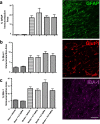Phosphodiesterase 10A Inhibition Leads to Brain Region-Specific Recovery Based on Stroke Type
- PMID: 32378029
- PMCID: PMC7644574
- DOI: 10.1007/s12975-020-00819-8
Phosphodiesterase 10A Inhibition Leads to Brain Region-Specific Recovery Based on Stroke Type
Erratum in
-
Correction to: Phosphodiesterase 10A Inhibition Leads to Brain Region-Specific Recovery Based on Stroke Type.Transl Stroke Res. 2021 Aug;12(4):691. doi: 10.1007/s12975-020-00858-1. Transl Stroke Res. 2021. PMID: 33123953 Free PMC article. No abstract available.
Abstract
Stroke is the leading cause of adult disability. Recovery of function after stroke involves signaling events that are mediated by cAMP and cGMP pathways, such as axonal sprouting, neurogenesis, and synaptic plasticity. cAMP and cGMP are degraded by phosphodiesterases (PDEs), which are differentially expressed in brain regions. PDE10A is highly expressed in the basal ganglia/striatum. We tested a novel PDE10A inhibitor (TAK-063) for its effects on functional recovery. Stroke was produced in mice in the cortex or the striatum. Behavioral recovery was measured to 9 weeks. Tissue outcome measures included analysis of growth factor levels, angiogenesis, neurogenesis, gliogenesis, and inflammation. TAK-063 improved motor recovery after striatal stroke in a dose-related manner, but not in cortical stroke. Recovery of motor function correlated with increases in striatal brain-derived neurotrophic factor. TAK-063 treatment also increased motor system axonal connections. Stroke affects distinct brain regions, with each comprising different cellular and molecular elements. Inhibition of PDE10A improved recovery of function after striatal but not cortical stroke, consistent with its brain localization. This experiment is the first demonstration of brain region-specific enhanced functional recovery after stroke, and indicates that differential molecular signaling between brain regions can be exploited to improve recovery based on stroke subtype.
Keywords: Angiogenesis; Axonal sprouting; BDNF; Repair; Striatum.
Conflict of interest statement
S Thomas Carmichael has received a research grant from Takeda Pharmaceutical Company Limited. This funder had no role in data analysis or interpretation. Kazunori Suzuki and Haruhide Kimura are employed by Takeda Pharmaceutical Company Limited. As experts in TAK-063, these two authors had a role in experimental design but no role in data analysis or interpretation.
Figures






Similar articles
-
Phosphodiesterase 10A deactivation induces long-term neurological recovery, Peri-infarct remodeling and pyramidal tract plasticity after transient focal cerebral ischemia in mice.Exp Neurol. 2022 Dec;358:114221. doi: 10.1016/j.expneurol.2022.114221. Epub 2022 Sep 6. Exp Neurol. 2022. PMID: 36075453
-
Phosphodiesterase-10A Inverse Changes in Striatopallidal and Striatoentopeduncular Pathways of a Transgenic Mouse Model of DYT1 Dystonia.J Neurosci. 2017 Feb 22;37(8):2112-2124. doi: 10.1523/JNEUROSCI.3207-15.2016. Epub 2017 Jan 23. J Neurosci. 2017. PMID: 28115486 Free PMC article.
-
Striatal phosphodiesterase mRNA and protein levels are reduced in Huntington's disease transgenic mice prior to the onset of motor symptoms.Neuroscience. 2004;123(4):967-81. doi: 10.1016/j.neuroscience.2003.11.009. Neuroscience. 2004. PMID: 14751289
-
Phosphodiesterase 10A inhibitors: a novel approach to the treatment of the symptoms of schizophrenia.Curr Opin Investig Drugs. 2007 Jan;8(1):54-9. Curr Opin Investig Drugs. 2007. PMID: 17263185 Review.
-
Emerging biology of PDE10A.Curr Pharm Des. 2015;21(3):378-88. doi: 10.2174/1381612820666140826114744. Curr Pharm Des. 2015. PMID: 25159072 Review.
Cited by
-
Encouraging an excitable brain state: mechanisms of brain repair in stroke.Nat Rev Neurosci. 2021 Jan;22(1):38-53. doi: 10.1038/s41583-020-00396-7. Epub 2020 Nov 12. Nat Rev Neurosci. 2021. PMID: 33184469 Free PMC article. Review.
-
Delayed atomoxetine or fluoxetine treatment coupled with limited voluntary running promotes motor recovery in mice after ischemic stroke.Neural Regen Res. 2021 Jul;16(7):1244-1251. doi: 10.4103/1673-5374.301031. Neural Regen Res. 2021. PMID: 33318401 Free PMC article.
-
Novel potential neuroprotective targets for DengZhanXiXin injection in middle cerebral artery occlusion rats recommended by quantitative proteomics and simulated docking.Front Neurosci. 2025 Jul 7;19:1499214. doi: 10.3389/fnins.2025.1499214. eCollection 2025. Front Neurosci. 2025. PMID: 40692577 Free PMC article.
-
PDE2A Inhibition Enhances Axonal Sprouting, Functional Connectivity, and Recovery after Stroke.J Neurosci. 2022 Nov 2;42(44):8225-8236. doi: 10.1523/JNEUROSCI.0730-22.2022. Epub 2022 Sep 26. J Neurosci. 2022. PMID: 36163142 Free PMC article.
-
A PDE10A inhibitor CPL500036 is a novel agent modulating striatal function devoid of most neuroleptic side-effects.Front Pharmacol. 2022 Nov 9;13:999685. doi: 10.3389/fphar.2022.999685. eCollection 2022. Front Pharmacol. 2022. PMID: 36438799 Free PMC article.
References
-
- Pollock A, Baer G, Campbell P, Choo PL, Forster A, Morris J, Pomeroy VM, Langhorne P, Cochrane Stroke Group Physical rehabilitation approaches for the recovery of function and mobility following stroke. Cochrane Database Syst Rev. 2014;4:CD001920. doi: 10.1002/14651858.CD001920.pub3. - DOI - PMC - PubMed
Publication types
MeSH terms
Substances
Grants and funding
LinkOut - more resources
Full Text Sources
Medical
Miscellaneous

